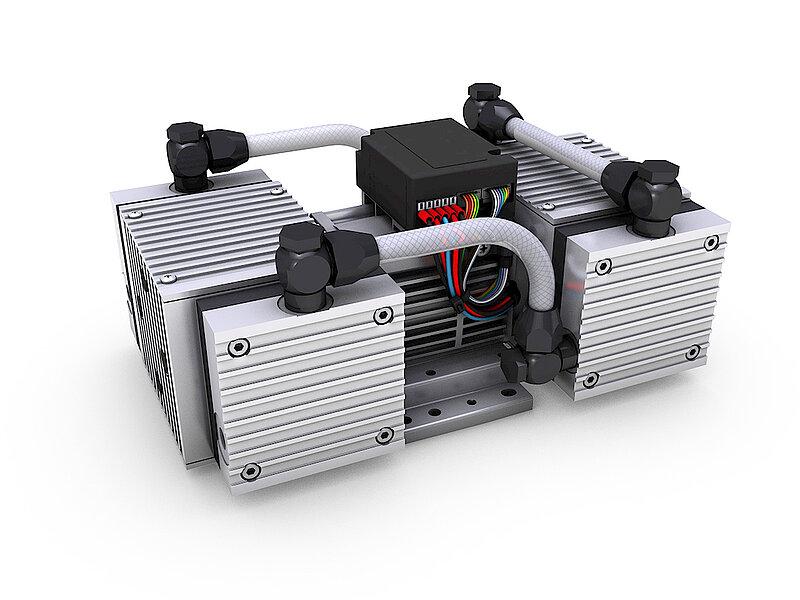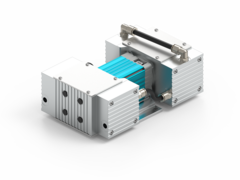KNF diaphragm gas pumps transfer or compress gases and vapors and generate vacuum without contaminating t...
Vacuum Pumps for Sustainable Refrigeration Technology with Water as Refrigerant
KNF is proud to play a crucial role in a new cooling technology, which uses water as a refrigerant in an unprecedented and innovative way.

The innovative technology is used in a water-based cooling system to cool cabinets, data centers, industrial processes and buildings with the pure natural refrigerant and zero emissions. The inherent system requires a constant and precise vacuum. This is where a customized vacuum pump from the KNF N 813.3 series comes into play.
Global Search for Better Refrigerants
Cooling is needed in many industries throughout the year, like in industrial manufacturing processes or for machine and cabinet cooling, but also in IT and for comfort cooling in offices and residential buildings. Cooling plays an important role in controlling energy costs and complying with energy efficiency regulations. It can also eliminate costly losses due to damaged IT equipment, machines or food spoilage.
Most refrigeration systems rely on traditional refrigerants like fluorinated gases (F-gases), ammonia or propane. However, these conventional refrigerants pose threats to the environment, safety, and human health. F-gases contribute to ozone depletion and global warming while ammonia is toxic and propane inflammable. Therefore, there has been a widespread search for safe, clean, sustainable and affordable refrigerants.
Pure Water Enables Superior Efficiency and Reduces Emissions
As a pioneer, the technology’s inventor has designed a cooling system that relies on pure water, also called R718 to be used as a natural refrigerant. With this technology, the solution is the first and only water-based chiller in the world to be mass-produced. The core of the technology is that water as highly energy driven refrigerant works in a closed circuit where it is continuously evaporated, compressed and condensed.
The main advantages lie in the technology's outstanding efficiency and sustainability. It enables electricity savings of up to 80 percent compared to current conventional cooling systems and generates almost zero CO2 emissions. Because it uses only water, the technology poses no risk to humans or the environment. Filling the system, service, and maintenance, including the recycling is simple and no need to lean on of safety regulations like the ones used for traditional refrigerants.
Cutting-edge Vacuum Pump for Water-based Technology Needed
Water can be used as a refrigerant thanks to a precise and constant vacuum in the system, which needs to be maintained during all operations. Only under the right vacuum does water undergo the changes of state at temperatures required for using water as a refrigerant. This creates high demands on the vacuum pump. It needs to operate in areas between 10 and 100 mbar abs. and in temperature ranges from 5 °C to 45 °C. In addition, the pump must operate oil-free and reliably over long periods without maintenance.
A small footprint and a general high robustness are vital, and the pumps must be able to cope with the challenging steam environment in the chiller. Therefore, diaphragm pump technology is ideal for the task and ultimately led to a collaboration between the system’s manufacturer and KNF, the leader in diaphragm pump technology.

Specially Customized Vacuum Pump for Water-based Technology
The final pump used in the system is based on the KNF N 813.3 series, tailored to the specific customer application. For a higher rotational speed, the motor has been digitally parametrized. This is possible because the brushless DC motor is an in-house developed component, allowing KNF to make advanced digital adjustments. On the suction side, the pump was fitted with a head plate with permanently open gas ballast, a filter and a nozzle. The gas ballast helps remove condensate from the pump, ensuring ideal performance.
Despite its powerful performance and the high motor rotation speed, the vacuum pump operates very quietly and with low vibration. This opens the possibility to use the chiller in residential buildings and in manufacturing processes where low-noise operation is important. This example illustrates how the quality of one component like a pump can have a major effect on the entire system and its applicability for different areas. It also shows that customizing a pump collaboratively can lead to solutions that would otherwise not have been possible.

